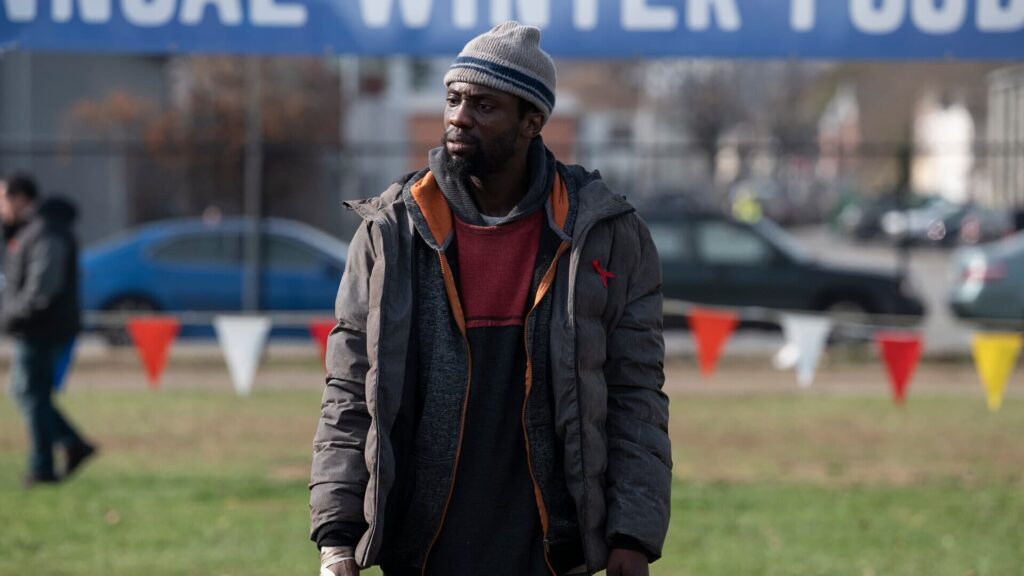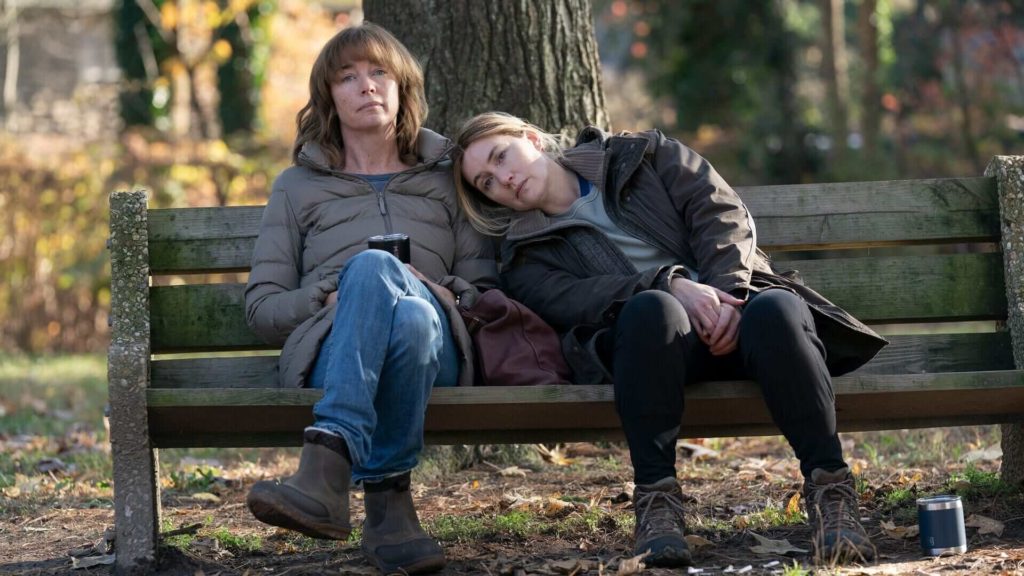Mare of Easttown

TV, Mini Series, 2021, TV-MA, 1h
Table of Contents
What Is Mare of Easttown About?
A small-town Pennsylvania detective attempts to investigate a local murder while her life is crumbling around her.
Why You Should Watch Mare of Easttown
Mare of Easttown, an enthralling HBO miniseries, emerges as a standout in the crime drama genre, not just for its intricate plot but also for its exceptional character development and stellar performances. This seven-episode series, set in a small Pennsylvania town, revolves around Detective Mare Sheehan, played by the incomparable Kate Winslet, who delivers a performance that is both deeply moving and fiercely authentic. Winslet embodies Mare with a complexity and grittiness that is rarely seen on television, turning her into a character who is not only compelling but profoundly relatable.
At the heart of the series is a gripping mystery – the murder of a local teenage mother – that serves as the narrative’s driving force. However, what sets Mare of Easttown apart is its profound exploration of its characters’ lives. The show delves deeply into the personal struggles and relationships of its characters, making the town and its inhabitants feel incredibly real and multidimensional. This focus on character development elevates the series beyond a typical whodunit, creating a rich tapestry of human stories interwoven with the central mystery.

The supporting cast also delivers outstanding performances, adding depth and nuance to the story. Julianne Nicholson, as Mare’s best friend Lori, and Jean Smart, playing Mare’s mother, stand out with their portrayals, bringing both warmth and complexity to their roles. Their interactions with Winslet are a highlight, showcasing a nuanced understanding of the intricacies of female friendships and family dynamics.
The narrative pacing of Mare of Easttown is another of its strengths. The series masterfully balances the unfolding of the central mystery with the development of its characters’ personal stories. Each episode builds tension and adds layers to the mystery, keeping viewers engaged and guessing. The plot twists are well-crafted, neither too predictable nor far-fetched, and they contribute meaningfully to the overall story arc.
The portrayal of a small-town community is also noteworthy. The series captures the essence of small-town life – the close-knit relationships, the shared history, and the way secrets can both bind and divide. This backdrop serves as more than just a setting; it’s integral to understanding the characters and their motivations. The town of Easttown becomes a character in its own right, with its traditions, flaws, and resilience playing a key role in the narrative.

Moreover, Mare of Easttown addresses several serious issues with sensitivity and insight. The show touches on themes such as grief, family dynamics, and the challenges of overcoming personal demons. It handles these topics with a deftness that avoids cliché, offering instead a thoughtful and often poignant exploration of the human condition.
In conclusion, Mare of Easttown is a triumph in storytelling. Its strength lies in its ability to weave a compelling mystery with rich character studies. Kate Winslet delivers a career-defining performance, supported by a talented cast and a well-paced narrative. The series is a must-watch for anyone who appreciates deeply human stories set against the backdrop of a captivating mystery. It’s a testament to the power of television to tell stories that are both enthralling and emotionally resonant.
The Theme of Mare of Easttown
The central theme revolves around the intricacies of human suffering and resilience. Mare Sheehan, portrayed by Kate Winslet, is a detective in a small Pennsylvania town grappling with profound personal grief and loss. Her character embodies the struggle of balancing professional responsibilities with personal demons. The show meticulously portrays how past traumas, like the loss of her son and the disintegration of her family, continually shape Mare’s present actions and decisions. This depiction of grief and trauma is nuanced and raw, avoiding the usual tropes and instead offering a more authentic, sometimes uncomfortable, look at human sorrow and coping mechanisms.
Another significant theme is the examination of community and its impact on individuals. Easttown, depicted as a tight-knit community, is a character in its own right. The series shows how the community’s interconnectedness can be both a source of support and a web of gossip and judgment. It highlights the societal pressures and expectations placed on individuals, often leading to profound consequences when those expectations are not met. The community’s reaction to the central crime, the disappearance and murder of a local girl, serves as a microcosm of how tragedies can ripple through small communities, affecting everyone in different, often unforeseen ways.

The show also tackles the theme of motherhood in its various forms and complexities. It explores different maternal relationships – between Mare and her daughter, the missing girl and her mother, and several other secondary characters. Each relationship presents a different facet of motherhood, from self-sacrifice to the burdens of expectations and the pain of loss. These portrayals offer a diverse look at what it means to be a mother and how this role intersects with individual identity.
Furthermore, Mare of Easttown delves into the theme of moral ambiguity. The series challenges the viewer’s sense of right and wrong, presenting characters that are deeply flawed yet relatable. Mare, for instance, is a hero but not without faults. Her pursuit of justice is sometimes clouded by her personal biases and pain, raising questions about the nature of justice and the means used to achieve it. This moral complexity extends to other characters, too, presenting a world where good and bad are not black and white but exist in shades of grey.
Lastly, the series subtly addresses issues of class and economic hardship. Easttown is shown as a town struggling with economic decline, which impacts its residents in various ways. This backdrop adds another layer to the characters’ motivations and actions, highlighting how socio-economic factors can influence life choices and the community’s fabric.
The Cinematography of Mare of Easttown
The cinematography of Mare of Easttown plays a pivotal role in establishing the series’ tone and enhancing its narrative depth. The show’s visual storytelling is characterized by a muted color palette, naturalistic lighting, and intimate framing, all of which contribute to its gritty, realistic atmosphere.
The use of a subdued color scheme is particularly striking. The cinematography leans heavily on greys, blues, and earth tones, reflecting the somber mood of the story and the emotional state of its characters. This choice also mirrors the bleak, winter setting of a small Pennsylvanian town, underpinning the themes of despair and hardship that permeate the series.

Natural lighting is a key element, adding authenticity and a sense of rawness to the scenes. The filmmakers often utilize available light sources, such as dim room lighting or overcast outdoor conditions, to create a more immersive and believable environment. This approach not only grounds the series in reality but also visually echoes the characters’ emotional struggles and the town’s economic hardship.
Moreover, the cinematography employs intimate framing and close-ups to delve into the characters’ inner worlds. This technique is particularly effective in capturing subtle expressions and unspoken emotions, allowing viewers to connect more deeply with the characters. It also reinforces the sense of claustrophobia and introspection, drawing attention to the personal conflicts and internal dilemmas faced by the protagonists.
The Soundtrack of Mare of Easttown
Mare of Easttown features a mix of original score music and popular songs. The score is composed by Jon Ekstrand and adds to the atmosphere and mood of the series, creating a sense of tension and unease during the more dramatic moments and a sense of warmth and nostalgia during the more intimate moments.
The soundtrack also features popular songs from a variety of artists, including:
- “Go Your Own Way” by Fleetwood Mac
- “Tangled Up in Blue” by Bob Dylan
- “Wild Night” by Van Morrison
- “Racing in the Street” by Bruce Springsteen
- “Don’t Stop” by Fleetwood Mac
- “Into the Mystic” by Van Morrison
- “Only a Memory” by The Smithereens
- “Tangled Up in You” by Staind
- “Dream Baby (How Long Must I Dream)” by Roy Orbison
- “Atlantic City” by Bruce Springsteen.
The Cast of Mare of Easttown
- Kate Winslet as Mare Sheehan, a police detective in the small town of Easttown, Pennsylvania.
- Julianne Nicholson as Lori Ross, Mare’s best friend and the owner of a local bar.
- Evan Peters as Dylan Hinchey, a local man who is a person of interest in a murder investigation.
- Guy Pearce as Richard Ryan, a detective from Philadelphia who is brought in to help with the case.
The Filmmakers of Mare of Easttown
- Director: Craig Zobel
- Writer: Brad Ingelsby
- Executive Producers: Kate Winslet, Brad Ingelsby, Gordon Gray, Barry Levinson, Kevin Turen, Nicole Kidman, and Per Saari.
- Producers: Megan Ellison, Dede Gardner, and Jeremy Kleiner.

Philly Cheesesteak Casserole

Inspiration
Show Setting

More About Mare of Easttown
Mare of Easttown is set in the fictional small town of Easttown, located in Delaware County, Pennsylvania. The series creates a rich and complex depiction of life in a small town, where everyone knows everyone and their secrets. The location plays an important role in the show, as the close-knit community and tight-knit social dynamics contribute to the tension and drama of the central murder investigation.
The location also highlights the economic and cultural differences within the town, as well as the impact that the town’s history and heritage has on its present and future. The depiction of Easttown is rich in detail, from its blue-collar roots to its sprawling farmlands and forests. The use of location is a key part of the show’s immersive atmosphere, and helps to bring the story and its characters to life.
“Mare of Easttown” was primarily filmed in and around the suburbs of Philadelphia, Pennsylvania. The show aimed to authentically capture the spirit and atmosphere of a small town in this region. The filming locations included various towns and neighborhoods in the Delaware County area, known locally as “Delco.”
Key locations used in the series include Wallingford, Aston, Drexel Hill, and Coatesville, among others. These areas provided the distinct, gritty, and authentic backdrop that was crucial for establishing the show’s setting and atmosphere. The choice of these locations also played a significant role in accurately portraying the cultural and socio-economic environment of a small town in Pennsylvania, contributing to the series’ realism and depth.
The production made use of local homes, streets, businesses, and other community landmarks, adding to the series’ realistic feel and helping viewers immerse themselves in the world of Easttown. This attention to location detail helped the show resonate with both local viewers familiar with the area and a broader audience appreciating the authentic portrayal of a specific American community.

